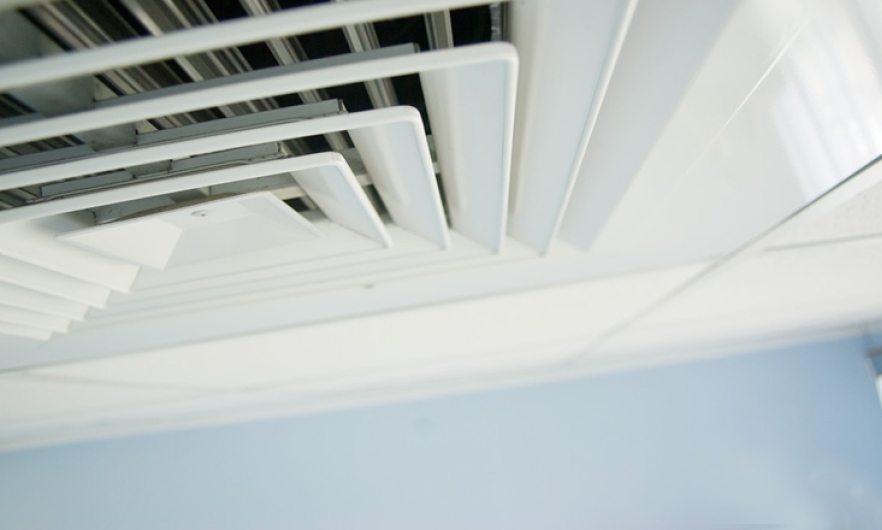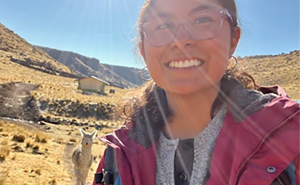How Indoor Ventilation Systems Can Help Prevent or Permit the Spread of COVID-19

Outdoor interactions are safer when it comes to COVID-19, but what can be done to improve ventilation in buildings?
INTERVIEW BY STEPHANIE DESMON
Indoor ventilation systems could help prevent the spread of COVID-19, but they may also make things worse.
Stephanie Desmon talks with Ana María Rule, PhD ’05, MHS ’98, a ventilation expert and assistant professor in Environmental Health and Engineering, about how ventilation systems can reduce the risk of exposure, whether heating and air conditioning are different, and whether airplanes’ ventilation systems are better or worse than buildings’. Rule also breaks down a case study of a restaurant in China that traced an outbreak of COVID-19 to poor ventilation.
STEPHANIE DESMON: We’re hearing a lot more about how the virus can be spread by ventilation systems. Can you talk about what the risks are?
ANA RULE: In general—even before COVID—we used ventilation systems to reduce the risk of exposures to any harm that is in the air.
So, we should see ventilation systems as our friends in this quest to control or to help with the virus. Having said that, the ventilation system should be well-maintained and should be working as expected. Filters should be in place—the best filters that are available. Not all ventilation systems are able to move air through really high-efficiency filters, but most systems can handle relatively high-efficiency filters that are able to control the virus. So in general, ventilation systems are used to minimize the risk in indoor environments. They should not increase the risk.
SD: Should we be trying to improve the filters that we use in buildings?
AR: This is typically not something that you and I would do in our homes. You can, of course, buy a better filter and try to improve the ventilation in your home. But in buildings, we need to contact the experts. The maintenance facilities and janitorial staff know the ventilation systems, so they are the ones that you should be relying on.
For a couple of months, we have been seeing this whole emphasis on ventilation, and the building facilities people have already been improving their systems: checking that everything is working and increasing the airflow.
If you're really worried about the air in your building, contact your facilities or janitorial person or the manager. There's very little that you're going to be able to do personally.
SD: We all know that the virus spreads more indoors than out. Why is that?
AR: It's a relatively simple question of concentration. You can imagine a plume when, for example, somebody is smoking. When you exhale the cigarette smoke, immediately you see this plume. The more air circulation and airflow in the space, then the easier that plume is going to dissipate and the particles will dilute. All aerosols work the same, and so there are a couple of things that happen indoors.
First of all, you may have a higher concentration of people indoors. If you have two or three people that may be infected, they may be generating these particles that are carrying viruses. Then, if you have low ventilation or low airflow, those particles or those concentrations just accumulate. That's one of the reasons that indoors is higher risk. You increase the concentration because you increase the number of people and there is lower ventilation.
But if you increase the ventilation and reduce the number of people—which is what we have been trying to do with the stay-at-home orders—then that reduces the risk of increasing the concentration and improves the chances of not being infected.
SD: We heard that in China, an air conditioning system may have spread the virus. Does air conditioning help or hurt?
AR: This particular case that was published about the ventilation system was very interesting. It was a case of a really, really badly designed ventilation system.
If you read the paper, the case was at a relatively big restaurant. It had the fan on one end, pushing air toward the building, and then on that same fan—on that same ventilation unit—was the return air. So the air was just being kind of shot for a little bit and then brought back in, and that's not how you are supposed to design a ventilation system. You're supposed to have the exhaust on one end and the inlet on another end.
The air was not being filtered. It was just recirculated without any filtering, and there was high density. There were, I think, three or four of the tables, side by side, and all of them were occupied. And so, this is a very good case of what not to do. But in general, ventilation systems are supposed to help, not hurt.
SD: We are heading toward the end of summer and the beginning of when you might use heat. What’s the difference between air conditioning and heating, and is one better for ventilation?
AR: In all ventilation systems, there are a couple of very simple parts: the fan or the motor that moves the air, the filter that traps contaminants before the air is introduced into the place, and then heating or cooling, depending on the season. So, it's typically the same ventilation system; it's just a slightly different route that it takes, whether you need to heat it or cool it. A well-maintained system with the proper filters and the right fan, moving enough air through the system, should be enough both in the winter and the summer.
SD: Great! I’ve been reading a lot about airplanes. Are they worse than buildings or actually better because of their constant air circulation? Even though you’re in a really small, contained area, is it possibly better because of how much air is circulating?
AR: It’s exactly the same thing on airplanes.
I have read a couple of case studies of airplanes—I think it was SARS—where they traced back however many people got infected with one case. It turns out, the filters were not installed, and I think the plane was sitting on the tarmac for a couple of hours without any air conditioning. So again, it depends on the ventilation system.
But, in general, airplanes have really good ventilation systems. Unfortunately, they also pack people very closely together. So there are two things. There's a huge range of sizes of particles, some of them bigger, that can't be removed immediately with the ventilation system, and those particles can reach another person.
Also, there are different routes of exposure. You can inhale the aerosols or you can get direct contact from another person that is infected. Or you can touch surfaces and, like we've been hearing from the beginning—don't touch your face, don't touch your eyes, don't touch your mouth.
So, because there's this combination of three different ways that you can get infected, airplanes might not be the safest places to be, even though they have good ventilation.
SD: So, we’ve abandoned our offices and they’ve been empty for, in some cases, six months. When we do start to go back, are there concerns about getting sick in some other way? I’ve read about Legionnaire’s disease and I’m wondering if there are risks associated with going back to offices after all the time away?
AR: It is possible. But, some of the essential personnel that have been going to work while we safely work at home have been these maintenance and facilities people. And, believe me, they have been—in most of the places that I know—working overtime to make sure that those ventilation systems do not become a potential risk of what you mentioned.
Is there still a risk? Yes, I think there's still a risk. But I would like to think that the risk is relatively low. If you are concerned, and if you suspect that the building where your office is located has been completely shut down, make sure to contact your administrator or your facilities person. Good cleaning and good maintenance should be enough.
SD: Your message here is that a good ventilation system is going to help with COVID, and a bad one could make us really sick. A lot of school buildings are old and a lot of the windows don’t open. Are schools a potentially bad place for ventilation problems?
AR: Yes. I think this is one of the things that we have recognized for a couple of months now, that there's no easy answer, right? I'm sure there are some school districts that have really good buildings and really good ventilation. There's been a huge renovation efforts in Baltimore City. We have renovated a good proportion of the schools, but that's not the case in the rest of the U.S.
Most schools are, like you said, in relatively old buildings where I don't think investments have been made recently. So, it's on a case-by-case basis. Some schools may be OK, and some schools, maybe not so much.
SD: Is there a way to retrofit? Could you just throw a good HEPA filter onto an old school? Would that do anything?
AR: I don’t know if it’s that easy. Because a HEPA filter is so efficient, it's harder to pull air through it. People have maybe seen this with their vacuum cleaners—if you have a HEPA filter vacuum cleaner, it just sounds louder. The motor is more potent because it needs to pull air through more resistance—that is that filter. So not all ventilation systems can be retrofitted with a HEPA filter.
You can retrofit with the best filter available, but you would maybe need to change the motor, and that’s going to be a little more expensive than just putting in a filter.
Having said that, though, there are a couple of models that have used those portable air purifiers—HEPA air purifiers—which are relatively small, relatively inexpensive units that you can put in a couple of places, and those help move and clean the air. I don't know if I've seen data on it, but I have seen models.
There are some things that can be done. But it's definitely, like you say, not a completely safe environment.
SD: So, the bottom line is that ventilation is going to help. At the same time, we can’t crowd people, and older systems just aren’t going to be up to the task.
Stephanie Desmon is the cohost of the Public Health On Call podcast. She is the director of public relations and marketing for the Johns Hopkins Center for Communication Programs, the largest center at the Bloomberg School.
RELATED CONTENT
Public Health On Call
This conversation is excerpted from the September 10 episode of Public Health On Call.





